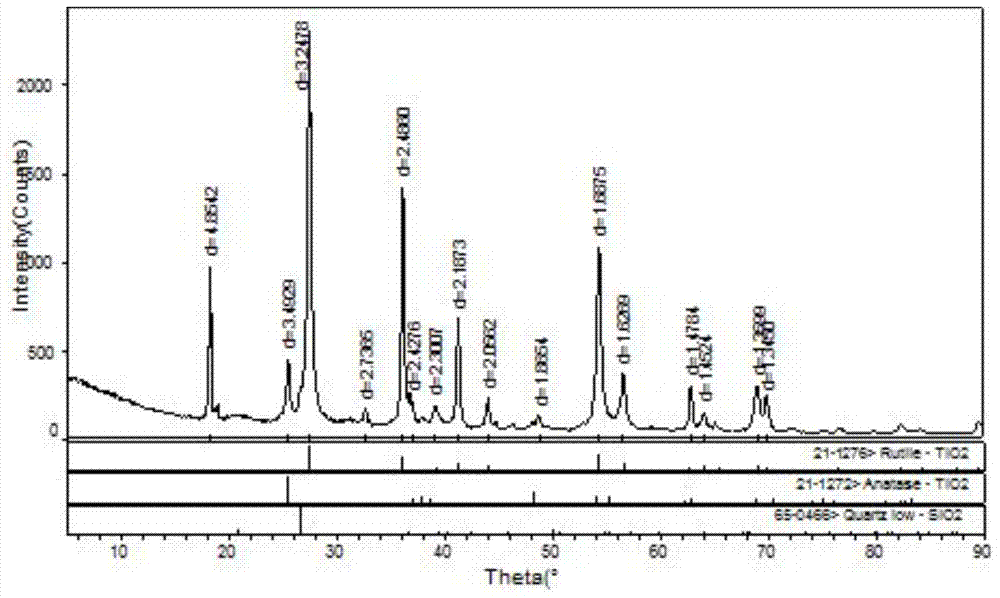Method for preparing rutile titanium dioxide by titanium slag
A titanium dioxide and rutile-type technology, applied in the direction of titanium dioxide, titanium oxide/hydroxide, etc., can solve the problems of long preparation process, weakened acidolysis performance, and large discharge of "three wastes", achieving obvious environmental benefits, less three wastes, The effect of short process
- Summary
- Abstract
- Description
- Claims
- Application Information
AI Technical Summary
Problems solved by technology
Method used
Image
Examples
Embodiment 1
[0026] The titanium slag is ground to ≤48 μm, and a 20% HCl solution with a mass concentration of 20% is added thereto, with a liquid-solid ratio of 10:1. After mixing evenly, put it into an autoclave and react at 150° C. for 10 hours to obtain a hydrothermal reaction product, and the leaching rate of titanium slag is 95%. The above reactant was filtered to obtain a mixture of titanium dioxide and silicon dioxide, and the reactant was washed with water and then leached with a NaOH solution with a concentration of 5 mol / L at a leaching temperature of 95° C. for 2 hours. After the leaching is completed, the solid and liquid are separated, the solid phase is washed with water to neutrality, and then dried at 100°C and dehydrated to obtain a rutile titanium dioxide product. Sodium silicate solution after solid-liquid separation with CO 2 Adjust the pH to prepare the by-product of white carbon black, and the obtained white carbon black is calcined at 550°C and its SiO 2 The conte...
Embodiment 2
[0028]Grind the titanium slag to ≤75 μm, add 25% HCl solution therein, and the liquid-solid ratio is 15:1. After mixing evenly, put it into an autoclave to react at 130° C. for 15 hours to obtain a hydrothermal reaction product, and the leaching rate of titanium slag is 95%. The above reactant was filtered to obtain a mixture of titanium dioxide and silicon dioxide, and the reactant was washed with water and then leached with a NaOH solution with a concentration of 5 mol / L at a leaching temperature of 95° C. for 2 hours. After the leaching is completed, the solid and liquid are separated, the solid phase is washed with water to neutrality, and then dried at 100°C and dehydrated to obtain a rutile titanium dioxide product. The sodium silicate solution after solid-liquid separation is adjusted with HCl solution to prepare the by-product of white carbon black, and the obtained white carbon black is calcined at 550°C and its SiO 2 The content is greater than 99%.
Embodiment 3
[0030] Grind the titanium slag to ≤45 μm, add 25% HCl solution therein, and the liquid-solid ratio is 8:1. After mixing evenly, put it into an autoclave and react at 180° C. for 6 hours to obtain a hydrothermal reaction product, and the leaching rate of titanium slag is 95%. The above reactant was filtered to obtain a mixture of titanium dioxide and silicon dioxide. The reactant was washed with water and then leached with a NaOH solution with a concentration of 7.5 mol / L. The leaching temperature was 90° C. for 2 hours. After the leaching is completed, the solid and liquid are separated, the solid phase is washed with water to neutrality, and then dried at 100°C and dehydrated to obtain a rutile titanium dioxide product. The sodium silicate solution after solid-liquid separation is adjusted with HCl solution to prepare the by-product of white carbon black, and the obtained white carbon black is calcined at 550°C and its SiO 2 The content is greater than 99%.
PUM
| Property | Measurement | Unit |
|---|---|---|
| particle diameter | aaaaa | aaaaa |
| particle size | aaaaa | aaaaa |
| diameter | aaaaa | aaaaa |
Abstract
Description
Claims
Application Information
 Login to View More
Login to View More - R&D
- Intellectual Property
- Life Sciences
- Materials
- Tech Scout
- Unparalleled Data Quality
- Higher Quality Content
- 60% Fewer Hallucinations
Browse by: Latest US Patents, China's latest patents, Technical Efficacy Thesaurus, Application Domain, Technology Topic, Popular Technical Reports.
© 2025 PatSnap. All rights reserved.Legal|Privacy policy|Modern Slavery Act Transparency Statement|Sitemap|About US| Contact US: help@patsnap.com


